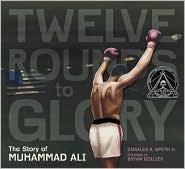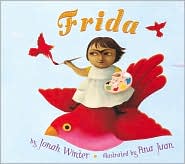Today's post is about a recent biography of Muhammad Ali. It's one of those new biographies that proves that there is more than one way to tell someone's life story. Similar to The Poet Slave of Cuba: A Biography of Juan Francisco Manzano (by Margarita Engle), Twelve Rounds to Glory: The Story of Muhammad Ali is a biography told in poetry.
 At the very end of last year, Candlewick Press put out a wonderful biography by Charles R. Smith Jr. called Twelve Rounds to Glory: The Story of Muhammad Ali, illustrated by Bryan Collier. Like the Engle book, this book won awards for its story-telling. Twelve Rounds to Glory won a Coretta Scott King honor as well as a Norman Sugarman Best Biography honor.
At the very end of last year, Candlewick Press put out a wonderful biography by Charles R. Smith Jr. called Twelve Rounds to Glory: The Story of Muhammad Ali, illustrated by Bryan Collier. Like the Engle book, this book won awards for its story-telling. Twelve Rounds to Glory won a Coretta Scott King honor as well as a Norman Sugarman Best Biography honor.The story of Ali's life is told in Ali-like verse that is separated into twelve chapters. Each chapter is a poem that describes an episode in Ali's life - his birth in the segregated south; his childhood and development as a boxer; his early boxing career and his Olympic achievement in Rome; the development of his brash public persona; his boxing bout with Sonny Liston that earned him his first heavyweight championship; his decision to embrace Islam, ditch his birth name (rooted in slavery) in favor of Muhammad Ali, and his position as a conscientious objector during the Vietnam war; the career ramifications of his decision to refuse to fight in the war; his loss in the fight with Frazier in Georgia (where he could fight because there was no boxing commission, including Ali's derision of Frazier as an "Uncle Tom") and subsequent fights setting up his challenge to reclaim the heavyweight championship; the "Rumble in the Jungle" - a title fight against reigning champ George Foreman in Zaire ("Ali! Boo-ma-YAY!" - "Ali, kill him!"); his rematch against Smokin' Joe Frazier and the ferocity of that particular match; a loss by decision to Leon Spinks, making Spinks the new heavyweight champion, followed by a decision to retire; the post-retirement bouts in order to earn a few paychecks, and the reasons for the need for money explained; and his out-of-the ring life as a father and, in later years, man with Parkinson's syndrome. The text of the book ends in 1998, with Ali lighting the Olympic torch in Atlanta. The timeline following the text runs through 2005, and his receipt of a Presidential Medal of Freedom, the opening of the Muhammad Ali Center in his hometown of Louisville, Kentucky, and his being awarded the Otto Hahn Peace Medal in Germany.
All of this could be the stuff of legend, but Charles Smith avoids the book becoming a panegyric. He keeps it real by including some of the bad along with the inspiring and the good. Ali was an inspired fighter and an inspirational speaker, but along with his uplifting words on race and the horrors of war, Ali generated some truly ugly taunts when it came to dealing with other fighters. Along with his dedication to the Muslim faith and his search for peace and integrity, Ali's personal relationships were not always terrific, whether it was with women or some of his staff. Because this biography is geared toward children ages 10 and up (middle school and, I would argue, high school), Smith doesn't go into graphic detail, but enough information is given to present at least the basic facts faithfully, without whitewashing any of it.
Here's a taste of the book. And if you'd like to hear it as well as (or instead of) reading it, Charles is only too happy to oblige, and you can access this (and three other poems) as audio files at his website.
ROUND ONE: The Golden Child
"I always felt like God made Muhammad special,
but I don't know why God chose me to carry this child."
—Odessa Clay, Cassius Clay's mother
Bathed in beautiful light
from parental love,
brown skin shimmers
with a glow from above.
In 1942, the seventeenth of January,
you entered the world
in Louisville, Kentucky.
Whites Only stores
and Whites Only parks
sifted you out
because you were dark.
No Negroes Allowed
and No Colored signs
created separate worlds
and drew color lines,
but your middle-class parents
managed to survive
through hard work and faith
and were able to provide
you, their first child,
and your little brother later,
with food, shelter, clothing,
and something much greater:
love
that was passed
to you from day one,
love
that was passed
to you, the new son
of mother Odessa
and father Cassius Clay,
who also passed the torch
of your name
that birth day,
passed down to you
from a white farmer who
inherited a plantation
and your great-grandfather too.
But Clay freed his forthy slaves
during America's dark days,
then fought to end slavery
and fought to change ways
and laws
and thinking
deep in the South,
using newspapers,
knives,
fists,
and his mouth.
He fought with a spirit
that lives in you today,
reflected in your name,
Cassius Marcellus Clay,
reflecting love from your parents,
who had faith and belief
that God would watch over you
and provide inner strength.
Now, in the actual book, this poem appears on one page, split into three columns, with a piece of art by Collier on the facing page showing the infant Ali lying atop a quilt. It is one of the shortest poems in the book, some of which go on for pages with multiple columns per page, which gives you an idea of the commitment that Smith had to getting the information right. The illustrations throughout the book are a combination of watercolor and collage, and they add a tremendous amount of impact to the text.
This book comes in at 80 pages, and those skinny columns and punchy rhymes (pun intended) push you along at a pretty good clip. And the word choices are wonderful, particularly in the fight scenes which actually get a bit too graphic for really young readers or squeamish girls in places, but I imagine that boys would read those same passages and call their friends over and read them again, looking at each other with awe and in glee and exclaiming "COOL!"
A sample of what I'm talking about, from "Round Seven: "Who You Callin' Tom?":
Out of nowhere like lightning
came a leaping left hook
filled with Uncle Tom anger
as Frazier's fist shook
your brain in your skull,
snapping your neck back,
when his fist met your jaw
with one mighty CRACK!
sending millions of ants
into your body as the mat
rose up to smack
your beaten brown back.
From later in the same chapter, and a fight with Ken Norton:
Ten fights,
ten wins,
all led up to Ken
Norton, a boxer
and former marine who
posed a big problem
for you in round two
when his rock-solid fist,
released from way back,
slingshot your cheek
and broke your jaw with a CRACK,
pooling your mouth with blood,
marinating your mouthpiece;
you continued to fight
using your ring expertise.
In all those 80 pages there are only a handful of what might be considered forced rhymes or manipulated line breaks, and to be honest, they're still in keeping with the nature of Ali's delivery style, which Smith channels extraordinarily well. Here's a quote from Smith's website that gives you an idea how Smith went about writing the poems in this remarkable book:
I wanted the book to represent every part of this remarkable man and do it in such a way that hasn’t been done before. Once I had all the facts, double and triple checked, I then had to put it into verse. Each word was chosen with care, which made each line strong, which made each verse strong, which made each chapter strong, which made the book strong. Since it’s about boxing, I wanted it to feel like a boxing match, so to do the fight scenes, I watched old movies of the actual fights and wrote down what I saw, starting with the introductions of each fighter and where it took place.
Most of the images inside the book include people, usually composed in collage format. The only inside spread I could find available on the 'net, however, is the image at the start of the final chapter, which appears not to involve collage, but to be a straight-up watercolor. Feast your eyes on the image that leads off the last chapter, "Round Twelve: Muhammad on the Mountain":

Charles R. Smith Jr. Boo-ma-YAY!















